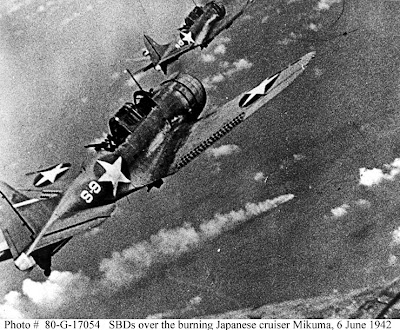Veterans commemorate Battle of Midway
MIDWAY ATOLL - Holding their hands over their hearts, six veterans of the Battle of Midway stood as a Navy band played the national anthem to commemorate the 65th anniversary of the fight that marked a turning point in World War II.
About 1,800 people ventured to this remote atoll Monday to honor those who served in the U.S. victory on the atoll 1,300 miles northwest of Honolulu, including other veterans and relatives of those who died.
"We salute the fallen warriors of the Battle of Midway. We remember their great victory and tremendous sacrifice," said Adm. Robert F. Willard, the U.S. Pacific Fleet commander. "We honor them with our eternal vigilance and combat readiness."
William Tunstall, 87, an aviation machinist mate 2nd class on the USS Hornet on June 4, 1942, said he felt lonesome as he remembered those who died.
"I lost a lot of good friends," said Tunstall, of Portland, Ore. (...)
Tunstall recalled helping the pilot and gunner of the torpedo plane he maintained climb aboard for their mission to bomb Japanese carriers approaching Midway.
But neither the pilot, Bill Abercrombie, nor the gunner, Bernie Phelps, ever returned. Of the 30 men in Torpedo Squadron 8 who took off on June 4, only one survived.
"From the time they left the carrier to today, I have no way of knowing what happened to them," Tunstall said.

The Battle of Midway is widely regarded as the most important naval battle of World War II.
The Japanese plan of attack was to lure America's few remaining carriers into a trap and sink them. They would then occupy Midway Atoll, extending Japan's defensive perimeter, and launch further attacks against Fiji, Samoa, and Hawaii. Had the Japanese captured Midway, the northeastern Pacific Rim would have been essentially defenseless.
The intended surprise attack was uncovered by Navy communications intelligence, allowing Admiral Chester W. Nimitz, Pacific Fleet commander, to establish an ambush by having his carriers ready and waiting.
Adm Nimitz's plan, together with the perserverance, sacrifice and skill of U.S. Navy aviators, led to the Japanese defeat at Midway Atoll. 307 men, one aircraft carrier, and 145 planes were lost. Japan's casualties were much higher, at 4,800. All four of the aircraft carriers Tokyo sent to Midway were destroyed, along with a heavy cruiser, three destroyers, and 291 planes.
The battle permanently weakened the Japanese Navy, particularly through the loss of over 200 naval aviators. Strategically, the U.S. Navy was able to seize the initiative in the Pacific and go on the offensive.

No comments:
Post a Comment